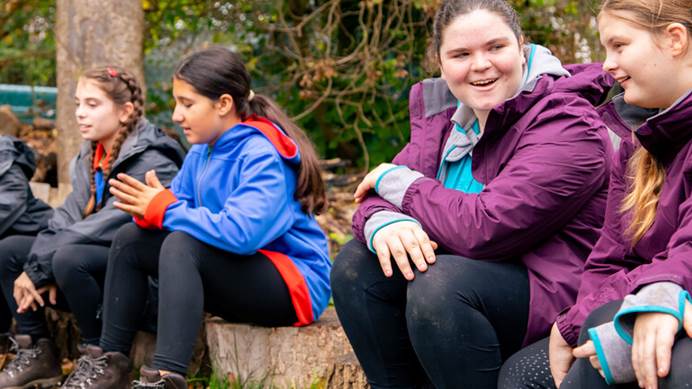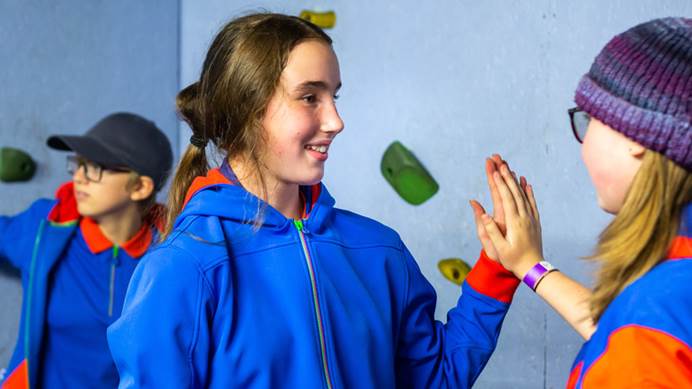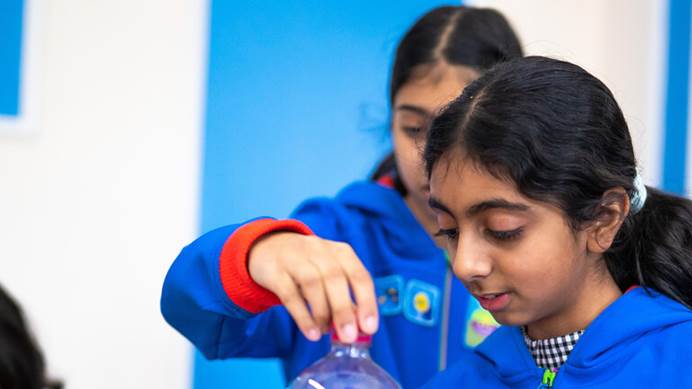Supporting trans members
What you should consider to support trans people within Girlguiding
We're an inclusive organisation and we want to ensure that all girls receive a great guiding experience.
Our inclusion guidance is here to help you to make your unit and activities inclusive of girls from all backgrounds. And help you talk to girls about difference and the importance of diversity and inclusivity in guiding.
It will help you to tailor support to girls with different needs, develop plans and risk assessments that keep all your members safe, and help you facilitate conversations with your young members and parents in order to create a safe space for everyone based on understanding and respect for all.
Including and supporting trans members
We’ve worked with a number of partners to develop this support and guidance, to help our members include trans people in guiding.
We hope you’ll find the answers to key questions you, our leaders, may have about supporting trans young members and volunteers.
Girlguiding promotes an inclusive and safe environment where all girls and young women, including trans girls and young women, should feel accepted. Non-binary people assigned female at birth and trans boys as new young members based on their sex should also feel welcome.
We know that no situation will be the same and, in some cases, you might need more support than given in this guidance. We encourage you, as well as all our volunteers, young members and parents, to get in touch with us if you need more specific advice on including our trans members.
You can contact the info team on [email protected] or phone 0207 834 6242.
Why is Girlguiding trans-inclusive?
Girlguiding believes that the needs of girls and young women are best met through a charity catering specifically for girls, and led by girls and women, as set out in our Royal Charter and backed-up by the views of our young members.
Our Royal Charter states that Girlguiding is for ‘…the primary object of educating girls and young women to help them develop emotionally, mentally, physically and spiritually so that they can make a positive contribution to their community and the wider world...’
As per our Royal Charter, we uphold our promise to support all girls and young women including trans girls and young women.
In line with our values of inclusion and changing as the lives of girls change, it’s important that we welcome trans girls and women. Our UK-wide annual survey into the views of girls and young women, the Girls’ Attitudes Survey, helps us to understand the changing lives of girls today. It found that 86% of girls and young women aged 11-21 believe people should not be discriminated against because they are transgender.
As a girl-only organisation with a trans-inclusive Equality and diversity policy, we treat trans girls and women according to the gender they have transitioned, or are proposing to transition, to. Meaning trans girls and trans women are welcome to be a part of our great charity.
The benefits to Girlguiding of being fully-inclusive are significant. We recognise the huge impact Girlguiding can have on each young member and volunteer. And it’s vital that trans girls and women – like all other girls and women – can contribute their experiences, time, commitment and skills to our charity.
Our volunteers and staff must make every effort to bring all our members together in a safe space where they can learn from each other and have a positive experience of guiding.
We will support our leaders, volunteers, young members and parents on a case-by-case basis to ensure a bespoke approach to including our trans members.
Balancing the needs and interests of different members is key to making Girlguiding an inclusive and safe space. We support our volunteers to lead and manage different situations where they need to uphold the requirements of our Equality and diversity policy, while balancing the interests of all our members.
Our trans-inclusive Equality and diversity policy and practice are underpinned by the law. See our What the law says page for a basic summary of the key laws that apply and what they say.
In this guidance we use the term trans to refer to people with the protected characteristic of gender reassignment.
We’ve used this term because it’s one of the broadest and most widely accepted words in current use. But, we know it’s not a term that everyone uses, and we recognise and respect an individual's right to choose how they are described.
We want to make it clear that this guidance is about supporting and including everyone who has an experience of gender that is like what we describe below. Even if they use other terms to describe themselves as well as, or instead of, trans. In particular, many people who transition will describe themselves as men or women, and no longer described themselves as trans.
Trans and similar words are descriptive terms and should be used as such, for example: ‘a trans person’, rather than ‘a trans’ or ‘a transgender’.
To understand who trans people are, it’s first useful to understand the difference between sex and gender.
Sex refers primarily to a person’s biological and physical characteristics, associated with the categories of female and male. It includes factors such as internal and external reproductive organs, chromosomes and hormonal make-up.
Gender refers to a person’s sense of self as, for example, a woman, man, or non-binary person (their gender identity). It also includes associated behavioural expressions (gender expression) which relate to how masculinity or femininity are expressed in a society or culture.
As a culture, we typically expect someone’s gender identity to align with their recorded sex, so gender gets recorded along with sex. This means we expect someone recorded as female at birth because of their biological sex to grow up to think of themselves as a girl and then a woman. And we expect someone recorded as male at birth because of their biological sex to grow up to think of themselves as a boy and then a man.
But, this isn’t the case for everyone. Sex doesn’t always determine gender identity. Around 1 in 100 people, maybe more, will find that the gender they have recorded at birth isn’t a good match for who they know themselves to be.
People who feel that the sex (and gender) recorded at birth does not match or sit easily with their own sense of gender may describe themselves as trans, or use a similar term.
This includes people with a very wide range of different experiences, such as people recorded as female at birth who know themselves to be men; people recorded as male at birth who know themselves to be women; people who do not consider themselves as either men or women (non-binary); and people who may experience or express different genders at different times.
People may question their gender for a period before coming to an understanding of who they are.
Some people then transition. Transitioning is a personal process of taking steps to change your recorded sex and gender-expression to one that matches your gender identity. This can involve social, medical or legal changes. If, how, and at what pace a person transitions are individual to them.
Young people under the age of 18 can transition socially, but they can’t get hormones or surgery, or change their legal sex. If they have parental consent, they can change the gender marker on their passport.
Some young trans people can get ‘hormone blockers’ – medications which put puberty on hold and delay their body from developing in ways they aren’t comfortable with.
There’s plenty more to learn about trans people and the diversity of their lives and experiences. Take a look at our list of organisations and resources that can help you are listed on this page.
The terms and descriptions used to talk about gender and gender identity are evolving all the time. We’ll check on this and keep the list below up to date.
Sex refers primarily to a person’s biological and physical characteristics, associated with the categories of male and female. It includes factors such as internal and external reproductive organs, chromosomes and hormonal make-up.
Sex is also a legal term and a protected characteristic, and it’s recorded on birth certificates. If a person obtains a Gender Recognition Certificate (GRC) they have legally changed their sex.
Gender reassignment is defined in the Equality Act 2010 as ‘A person has the protected characteristic of gender reassignment if the person is proposing to undergo, is undergoing or has undergone a process (or part of a process) to reassigning the person's sex by changing physiological or other attributes of sex’.
Gender reassignment is both a legal term and a protected characteristic.
Gender refers primarily to a person’s sense of self as, for example, a man, woman or non-binary person (their gender identity), and to associated behavioural expressions (gender expression) set within the social and cultural contexts related to masculinity and femininity.
Gender identity is not automatically determined by sex, although it is usually assumed that it is, as they very commonly correlate.
Sex/gender recorded at birth refers to the sex/gender someone was assumed to have, based on the genitals they had when they were born.
Trans is a term that some people who feel that the sex/gender recorded at birth does not match or sit easily with their sense of self can use to describe themselves. For example, a person recorded as female at birth whose gender identity is male/man.
Cisgender or cis can be used to describe people who feel that the sex/gender recorded at birth aligns well with their sense of self. For example, a person recorded as female at birth whose gender identity is female/woman. Sometimes thought of as the opposite of trans.
Gender identity is a person’s inner sense of their own gender as, for example, a man, woman or non-binary person. This may or may not correspond to the sex recorded at birth.
Gender expression refers to the cultural gender-related cues and behaviours a person uses, traditionally associated with masculinity and femininity. This includes name, pronoun, title, clothing, hair, walk, speech, mannerisms and any other gendered aspects of presentation.
Understanding the difference between gender identity and gender expression allows us to recognise that transition is mostly about changing gender expression (cultural gender cues) rather than gender identity (sense of self).
Transitioning is a process of moving from your recorded sex/gender expression to one that accords with your gender identity. This can refer to social, medical or legal changes.
Gender stereotypes are when certain characteristics, such as preferring a colour or an activity, are applied to an entire gender. For example, ‘all girls like pink’ is a very common stereotype.
If a child enjoys activities or expressing themself in a way that is stereotypically associated with a gender different to their recorded sex, this does not mean they are trans.
Gender non-conforming is a broad term that describes those who do not conform to social expectations of gender identities or gender expressions. Being gender non-conforming does not mean someone is trans, nor are all trans people gender non-conforming.
Pronouns are words we use to stand in for people’s names in conversation. These are often gendered - for example, he, she or they, him, her or them.
Trans girl/woman is someone recorded as male at birth whose gender identity is female (woman/girl). They may describe themselves as a woman with a trans history or simply a woman.
Trans boy/man is someone recorded as female at birth whose gender identity is male (man/boy). They may describe themselves as a man with a trans history or simply a man.
Non-binary refers to someone whose gender identity is not only male/man or female/woman. They may experience their gender as both male and female, or neither male nor female or take another approach to gender that doesn’t align with traditional binary ideas.
Transphobia is the fear or dislike of, or prejudice towards, someone based on the fact they’re trans. This includes the denial or refusal to accept their gender identity.
Get advice on including all
Contact us for more information and advice about including all girls and volunteers in guiding.
This guidance was developed with support from Stonewall and Gendered Intelligence.
What else you should know
Code of conduct and policy
We have a volunteer code of conduct in place as well as our policies which we expect all volunteers to adhere to. And there are procedures in place for addressing concerns about volunteers who may not be upholding those policies. These are updated from time to time and you should revisit them on a regular basis. See our policies pages for more information.
Media attention
We occasionally get enquiries from the media. If this happens, it’s important that you forward any queries from the external press to the PR team at HQ via your country or region communications staff member (if you have one). If you receive a press enquiry out of hours, please contact the on-call national press office on 07990 553940.


